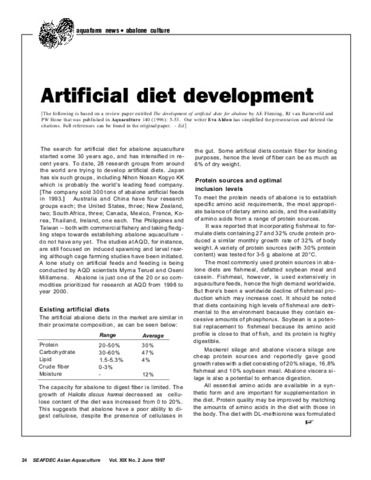Flakes versus noodles as feed for the abalone Haliotis asinina, does form matter?
| dc.contributor.author | Lebata-Ramos, Ma. Junemie Hazel | |
| dc.contributor.author | Binas, Joseph | |
| dc.contributor.author | Solis, Ellen Flor | |
| dc.contributor.author | Balinas, Vicente T. | |
| dc.date.accessioned | 2021-08-27T01:33:22Z | |
| dc.date.available | 2021-08-27T01:33:22Z | |
| dc.date.issued | 2021-12 | |
| dc.identifier.citation | Lebata-Ramos, Ma. J. H. L., Biñas, J. B., Solis, E. F. D., & Balinas, V. T. (2021). Flakes versus noodles as feed for the abalone Haliotis asinina, does form matter? Aquaculture Nutrition. https://doi.org/10.1111/anu.13325 | en |
| dc.identifier.issn | 1353-5773 | |
| dc.identifier.uri | http://hdl.handle.net/10862/6175 | |
| dc.description.abstract | This paper reports the first use of thin flakes (310–315 μm thick) formulated diets as feed for the abalone Haliotis asinina. The study compared noodles and flakes prepared using refined and unrefined diets developed earlier for H. asinina (Bautista-Teruel et al., J. Shellfish Res., 35, 2016, 633). Four treatment diets in triplicates (refined flakes, MBTr-F; refined noodles, MBTr-N; unrefined flakes, MBTur-F; and unrefined noodles, MBTur-N) were used in a feeding experiment conducted in a tank facility. After three months, abalone fed MBTr-F had significantly higher mean shell length and body weight (35.92 ± 0.36 mm, 9.24 ± 0.29 g) compared with those fed MBTr-N (34.63 ± 0.37 mm, 8.22 ± 0.28 g) and MBTur-N (34.23 ± 0.36 mm, 7.66 ± 0.26 g), but did not significantly differ with those fed MBTur-F (35.40 ± 0.30 mm, 8.57 ± 0.24 g). Likewise, abalone fed MBTr-F had significantly higher mean growth rates (5.31 ± 0.08 mm, 2.59 ± 0.06 g/month), compared with those fed MBTr-N (4.90 ± 0.19 mm, 2.26 ± 0.12 g/month) and MBTur-N (4.71 ± 0.02 mm, 2.07 ± 0.06 g/month), but did not significantly differ with those fed MBTur-F (5.11 ± 0.06 mm, 2.37 ± 0.04 g/month). Survival (96.67–98.89%) and FCR (2.2–2.5) did not significantly differ among treatment diets. Between the flaked diets, MBTur-F is the cheaper option. However, the use of this unrefined diet resulted in distinct turquoise abalone shell colour, not observed in those fed MBTr-F. | en |
| dc.description.sponsorship | The authors greatly appreciate SEAFDEC Aquaculture Department for funding the study (Study Code: FS-02-M2020T); the Abalone Hatchery staff for providing the abalone juveniles used in the study; the Feed Mill Plant staff for producing the feeds to the desired formulation and forms; Mr. Silverio Tibudan for his assistance in the conduct of the experiment; Mr. Manny Librodo for his assistance in improving the resolution of the figures; and the anonymous journal reviewers for painstakingly reviewing the manuscript. | en |
| dc.language.iso | en | en |
| dc.publisher | Wiley | en |
| dc.subject | abalones | en |
| dc.subject | Haliotis asinina | en |
| dc.subject | Flakes | en |
| dc.subject | Formulated diet | en |
| dc.subject | noodles | en |
| dc.subject.lcsh | SEAFDEC/AQD | en |
| dc.title | Flakes versus noodles as feed for the abalone Haliotis asinina, does form matter? | en |
| dc.type | Article | en |
| dc.identifier.doi | 10.1111/anu.13325 | |
| dc.citation.volume | 27 | |
| dc.citation.issue | 6 | |
| dc.citation.spage | 1880 | |
| dc.citation.epage | 1887 | |
| dc.citation.journalTitle | Aquaculture Nutrition | en |
| dc.subject.asfa | feeds | en |
| dc.subject.asfa | diet | en |
| dc.subject.asfa | feeding experiments | en |
| dc.subject.asfa | feeding | en |
| dc.subject.asfa | abalone culture | en |
| dc.identifier.essn | 1365-2095 |
Files in this item
| Files | Size | Format | View |
|---|---|---|---|
|
There are no files associated with this item. |
|||
This item appears in the following Collection(s)
-
Journal Articles [1256]
These papers were contributed by Department staff to various national and international journals.




